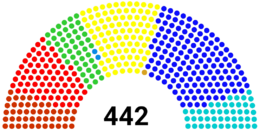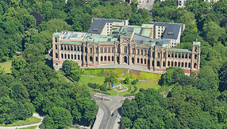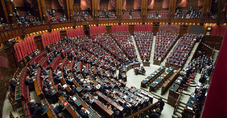Federal Chamber (Besmenia)
Besmenian Federal Chamber Besmenische Bundeskammer | |
|---|---|
 | |
| Type | |
| Type | |
Term limits | 4 years |
| History | |
| Founded | August 2, 1920 |
| Leadership | |
Vice Presidents of the Federal Chamber | |
| Structure | |
| Seats | 442 |
 | |
Political groups | Government (258):
Opposition (184):
|
| Elections | |
| Open list proportional representation | |
Last election | 2021 Besmenian federal election |
Next election | Next Besmenian federal election |
| Meeting place | |
 Federal Chamber building, Laitstadt | |
 | |
| Website | |
| www | |
The Federal Chamber (Besmenian: Bundeskammer), is the lower house of the Besmenian Parliament and is based in the Federal Chamber building in the Besmenian capital, Laitstadt. In accordance with the Basic Law, together with the Federal Senate, which represents the federal states, it is called upon to legislate at the federal level. Both chambers are set up as independent bodies. In general, initiatives are initially discussed by the Federal Chamber, with the Federal Senate acting as the confirming or rejecting body in the legislative process. In special cases, the Federal Chamber and the Federal Senate meet together as a Federal Assembly, for example when the president is sworn in.
Before 1967, the Federal Chamber had 210 members. In the course of the Besmenian reunification, membership increased by 427 MPs. After Palingia joined in April 2022, membership increased by 442 MEPs. Palingia's 15 MPs were determined by party percentage in the 2022 Pallingian state election. The parties that reached the 5% threshold in that election also got seats in the Federal Chamber.
The last Federal Chamber election was held on August 8, 2021. The next election is scheduled for August 2025, should the Federal Chamber not dissolve itself before then.
History
Competences of the Federal Chamber
Legislative process
In addition to the Federal Government and the Federal Senate, the Federal Chamber has the right to propose bills, the so-called right of initiative.
A bill introduced from within the Federal Chamber must be supported by a faction or five percent of MPs. The bills are usually discussed and drafted beforehand in the Federal Chamber committees. In this way they are made “ready for voting”. The draft is first discussed in the entire Federal Chamber and approved or rejected there. If the law is passed, it goes on to the Federal Senate for deliberation. A federal government bill is first referred to the Federal Senate, where it is discussed. Together with his statement and the counter-statement of the federal government, the bill is then submitted to the Federal Chamber. Conversely, a bill from the Federal Senate goes to the Federal Chamber along with the Federal Government's opinion.
If a law is passed by the Federal Chamber, the further cooperation of the Federal Senate is required for it to pass. A distinction must be made here as to whether it is an objection law or a consent law. The rejection of an objection law by the Federal Senate can be overruled in the Federal Chamber. If the Federal Senate does not agree to a consent law, it has failed.
Current composition of the Federal Chamber
| Group | Members | Leader | |
|---|---|---|---|
| Besmenian People's Party (BVP) | 142 / 442
|
Karsten Betzler | |
| Free Besmenian Citizen's Party (FBBP) | 92 / 442
|
Maria Herbst | |
| Social Democratic Union (SDU) | 69 / 442
|
Angelika Pauer | |
| Green Party of Besmenia (GPB) | 47 / 442
|
Stefan Tritter | |
| National Besmenian Party (NBP) | 45 / 442
|
Markus Ernst | |
| Party of the Besmenian Left (PBL) | 45 / 442
|
Ingrid Schencker | |
| PADBE - Democratic Palingia (PADBE) | 2 / 442
|
Christian Pöhlmann | |
Organization of MPs
Factions
Most members of the Federal Chamber are members of a faction. A faction is usually formed by MPs from the same party. A faction must have at least 5 members. A faction consisting of less than 5 members is called a group. The groups have fewer rights in the Federal Chamber than a faction; For example, they have no right to nominate a vice-president from among their members. MPs whose party has even fewer members in the Federal Chamber or who have resigned from or been expelled from their parliamentary group/group are non-attached MPs. They have all the rights and duties of an MEP in a parliamentary group or group, but not the rights of the parliamentary group or group itself.
Presidium
In the first session after the election to the Federal Chamber, the members elect the President of the Federal Chamber and two deputies. The President of the Federal Chamber traditionally comes from the largest faction in the Federal Chamber, regardless of whether that faction is a member of the governing coalition or in opposition. the two deputies come from the second and third largest factions. The members of the presidium take turns in chairing Federal Chambers meetings; Only at very important meetings does the President of the Federal Chamber actually preside for the entire duration of the meeting.
The President of the Federal Chamber has domiciliary rights in the Federal Chamber. He also makes the most important personnel decisions in the administration of the parliament. Formally, all letters from other constitutional bodies and also bills from the Federal Chamber are addressed to him. The President of the Federal Chamber is also the official deputy of the Besmenian President.
Presidents of the Federal Chamber
| Name | Took office | Left office | Party |
|---|---|---|---|
| Martin Strobel (1873-1951) | 1920 | 1924 | BDP |
| Wolfgang Stück (1876-1957) | 1924 | 1938 | BVP |
| Johannes Kreiger (1883-1960) | 1938 | 1944 | BVP |
| Bruno Wagner (1888-1974) | 1944 | 1956 | LBB |
| Rudolf Volker (1893-1973) | 1956 | 1960 | BVP |
| Viktor Wangenknecht (1905-1993) | 1960 | 1964 | BVP |
| Herbert Lehmberg (1913-1996) | 1964 | 1972 | SDU |
| Franz Missmahl (1929-2011) | 1972 | 1980 | BVP |
| Hertha Schuardt (1933-2021) | 1980 | 1993 | FBBP |
| Holger Kremfeld (1940-) | 1993 | 2001 | BVP |
| Hans Westphal (1945-) | 2001 | 2007 | FBBP |
| Gudrun Senf (1946-) | 2007 | 2012 | FBBP |
| Rupert Bödermann (1954-) | 2012 | Incumbent | BVP |
Elections
Due to the equal, direct, personal, free and secret suffrage of men and women who have reached the age of 16 on election day (since 2021, previously the age of 18), 442 members (MPs ) are elected.
List of elections to the Besmenian Federal Chamber
Latest election
| Party | Votes | % | Seats | |
|---|---|---|---|---|
| Besmenian People's Party | 17,775,672 | 30,8 | 137 | |
| Free Besmenian Citizen's Party | 11,658,071 | 20,2 | 90 | |
| Social Democratic Union | 8,426,130 | 14,6 | 65 | |
| Green Party of Besmenia | 6,175,314 | 10,7 | 47 | |
| Party of the Besmenian Left | 5,829,035 | 10,1 | 45 | |
| National Besmenian Party | 5,540,469 | 9,6 | 43 | |
| Other parties | 2,193,102 | 3,8 | 0 | |
| Invalid/blank votes | 115,426 | 0,2 | – | |
| Total | 57,713,219 | 100 | 427 | |
| Registered voters/turnout | 62,832,132 | 93,9 | – | |
It should be noted that the election took place before the accession of Palingia and the associated enlargement of the Federal Chamber.
Distribution of Federal Chamber seats by state
List of Federal Chamber sessions since 1920
| Session | Election | Seats | Government |
|---|---|---|---|
| 1. | 1920 | 210 | BDP-SDU-BKP majority |
| 2. | 1924 | 210 | BVP-SDU majority |
| 3. | 1928 | 210 | BVP-SDU majority |
| 4. | 1932 | 210 | BVP majority |
| 5. | 1936 | 210 | BVP-SDU majority |
| 6. | 1940 | 210 | BVP-FBBP majority |
| 7. | 1944 | 210 | FBBP-BVP majority |
| 8. | 1948 | 210 | FBBP-SDU majority |
| 9. | 1952 | 210 | FBBP-SDU majority |
| 10. | 1956 | 210 | BVP-SDU majority |
| 11. | 1960 | 210 | BVP-SDU majority |
| 12. | 1964 | 210 | SDU-BVP majority |
| 13. | 1968 | 427 | SDU-BVP majority |
| 14. | 1972 | 427 | BVP-BRP majority |
| 15. | 1976 | 427 | BVP-BRP majority |
| 16. | 1980 | 427 | FBBP-SDU minority |
| 17. | 1981 | 427 | FBBP-SDU majority |
| 18. | 1985 | 427 | FBBP-SDU majority |
| 19. | 1989 | 427 | FBBP-SDU majority |
| 20. | 1993 | 427 | BVP-GPB majority |
| 21. | 1997 | 427 | BVP-GPB minority |
| 22. | 2001 | 427 | FBBP-SDU majority |
| 23. | 2005 | 427 | FBBP-BVP majority |
| 24. | 2009 | 427 | FBBP-BVP majority |
| 25. | 2012 | 427 | BVP-SDU majority |
| 26. | 2016 | 427 | BVP-FBBP majority |
| 27. | 2020 | 427 | BVP-FBBP majority |
| 28. | 2021 | 427 | BVP-SDU-GPB majority |
